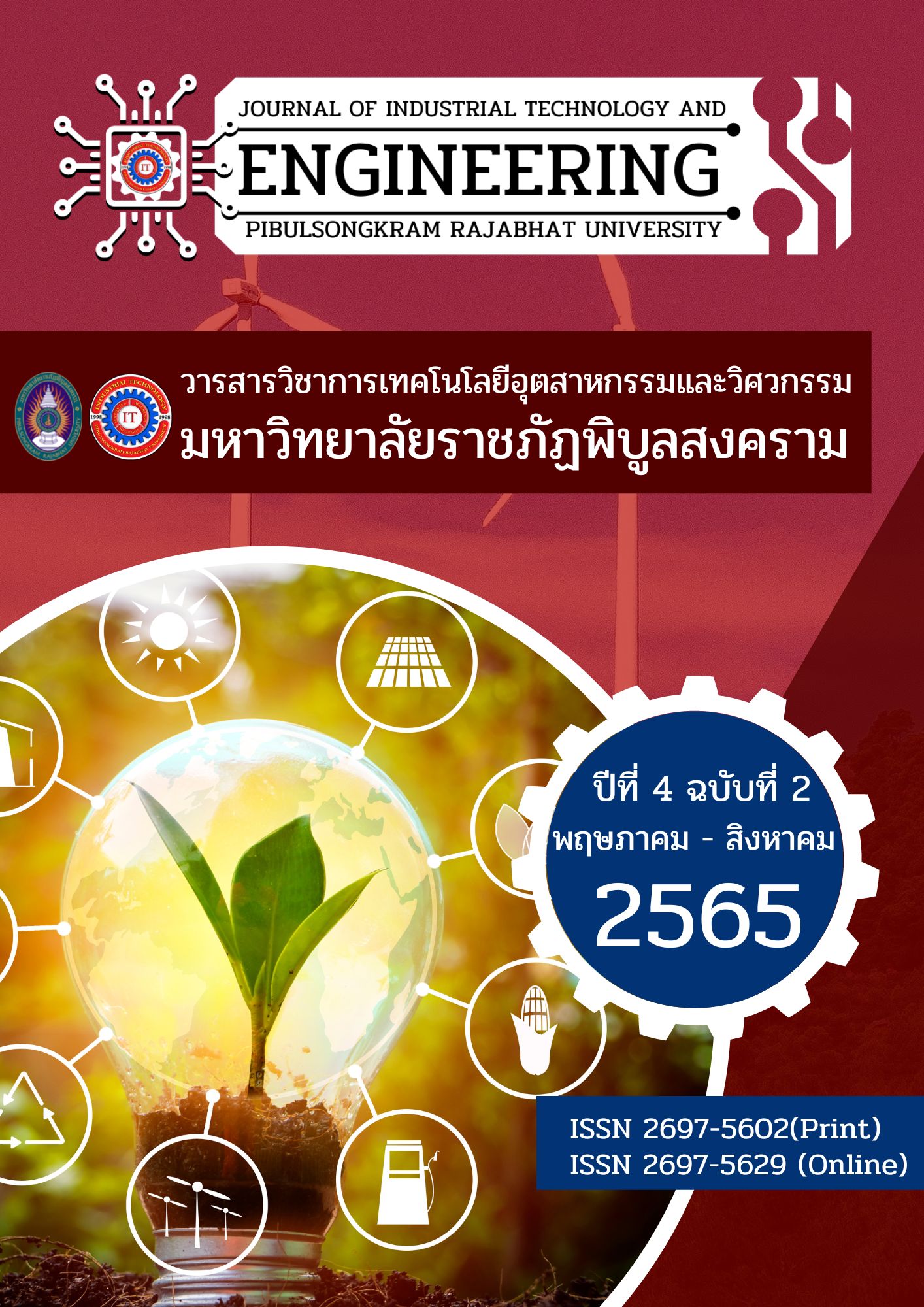การศึกษาสมรรถนะเครื่องขึ้นรูปเตาซุปเปอร์อั้งโล่
คำสำคัญ:
ความดันลมในการอัดขึ้นรูป, เครื่องขึ้นรูปเตาซุปเปอร์อั้งโล่, สมรรถนะบทคัดย่อ
ปัจจุบันการปั้นเตาซุปเปอร์อั้งโล่หรือที่เรียกว่า เตาหุงต้มประสิทธิภาพสูง นั้นทั้งหมดมีการปั้นด้วยมือ ปัญหาที่เกิดขึ้นพบว่ามาตรฐานของขนาดเตาไม่คงที่ส่งผลต่อการประกอบส่วนต่างๆ ของเตา และชาวบ้านหรือเกษตรกรมีความเมื่อยล้าจนกลายเป็นกล้ามเนื้ออักเสบ ประกอบกับไม่สามารถผลิตได้ทันกับความต้องการของตลาด ด้วยเหตุผลดังกล่าวงานวิจัยนี้จึงมีวัตถุประสงค์เพื่อศึกษาสมรรถนะเครื่องขึ้นรูปเตาซุปเปอร์อั้งโล่ ซึ่งเครื่องขึ้นรูปเตาซุปเปอร์อั้งโล่ประกอบด้วยส่วนของโครงสร้างทำจากเหล็ก ส่วนของแม่พิมพ์ตัวผู้และแม่พิมพ์ตัวเมียทำจากอลูมิเนียมอัลลอยด์ ส่วนของชุดสร้างความดันลมพร้อมอุปกรณ์ และส่วนสุดท้ายคือส่วนของการควบคุมการทำงาน โดยความดันลมที่ใช้ในการศึกษาประกอบด้วย 6 bar, 7 bar และ 8 bar ซึ่งมีเกณฑ์ที่ใช้ในการประเมินสมรรถนะเครื่องขึ้นรูปเตาซุปเปอร์อั้งโล่ ได้แก่ เปอร์เซ็นต์ความผิดพลาดของการขึ้นรูป อัตราการผลิตเตาซุปเปอร์อั้งโล่ ความสิ้นเปลืองพลังงานจำเพาะ ประสิทธิภาพเชิงความร้อน และความต้านทานแรงกด ผลที่ได้จากการศึกษาสามารถสรุปได้ดังต่อไปนี้ 1) ความดันลมมีผลต่อสมรรถนะเครื่องขึ้นรูปเตาซุปเปอร์อั้งโล่ 2) สมรรถนะเครื่องขึ้นรูปเตาซุปเปอร์อั้งโล่กรณีความดันลมเท่ากับ 8 bar สูงกว่า 7 bar และ 6 bar 3) เปอร์เซ็นต์ความผิดพลาดในการขึ้นรูปกรณีความดันเท่ากับ 8 bar ต่ำกว่า 7 bar และ 6 bar โดยเฉลี่ยประมาณ 92.75% และ 96.71% ตามลำดับ 4) อัตราการผลิตเตาซุปเปอร์อั้งโล่กรณีความดันลมเท่ากับ 8 bar สูงกว่า 7 bar และ 6 bar โดยเฉลี่ยประมาณ 25% และ 66.67% ตามลำดับ 5) ความสิ้นเปลืองพลังงานจำเพาะกรณีความดันลมเท่ากับ 8 bar น้อยกว่า 7 bar และ 6 bar โดยเฉลี่ยประมาณ 10.30% และ 22.91% 6) ประสิทธิภาพเชิงความร้อนของเตาซุปเปอร์อั้งโล่กรณีความดันลมเท่ากับ 8 bar มากกว่า 7 bar, 6 bar และการปั้นด้วยมือ โดยเฉลี่ยประมาณ 2.74%, 5.58% และ 15.77% ตามลำดับ และ 7) ความต้านทานแรงกดของผนังกรณีความดันลมเท่ากับ 8 bar มากกว่า 7 bar, 6 bar และการปั้นด้วยมือ โดยเฉลี่ยประมาณ 7.54%, 16.77% และ 31.46% ตามลำดับ
เอกสารอ้างอิง
Ayele, L., & Eneyew, Y. (2022). Experimental investigation on renovation of locally manufactured electrical cooking stove. Case Studies in Thermal Engineering, 30, 101712. Doi: https://doi.org/10.1016/j.csite.2021.101712
Aziz, S., Barua. S. & Chowdhury, S.A. (2022). Cooking energy use in Bangladesh: Evidence from technology and fuel Choice. Energy, 250, 123696.
Doi: https://doi.org/10.1016/j.energy.2022.123696
Bentson, S., Evitt, D., Still, D., Lieberman, D. & MacCarty, N. (2022). Retrofitting stoves with forced jets of primary air improves speed, emissions, and efficiency: Evidence from six types of biomass cookstoves. Energy for Sustainable Development, 71, 104–117.
Bonsu, B.O., Takase, M. & Mantey, J. (2020). Preparation of charcoal briquette from palm kernel shells: case study in Ghana. Heliyon, 6, e05266.
Doi: https://doi.org/10.1016/j.heliyon.2020.e05266
Das, D.K., Islam, M.S., Dutta, C.B., Hassan., M.M. & Hossen, S.S. (2021). Is there any demand for improved cooking stoves? Evidence from Bangladesh.
Journal of Environmental Management, 298, 113412.
Doi: https://doi.org/10.1016/j.jenvman.2021.113412
Duong, V.M., Flener, U., Hrbek, J., & Hofbauer, H. (2022). Emission characteristics from the combustion of Acacia Mangium in the automatic feeding pellet stove. Renewable Energy, 186, 183-194.
Hailu, A. (2022). Development and performance analysis of top lit updraft: natural
draft gasifier stoves with various feed stocks. Heliyon, 8, e10163.
Doi: https://doi.org/10.1016/j.heliyon.2022.e10163
Hakam, D.F., Nugraha, H., Wicaksono, A., Rahadi, R.A. & Kanugrahan, A.P. (2022).
Mega conversion from LPG to induction stove to achieve Indonesia’s
clean energy transition. Energy Strategy Reviews, 41, 100856.
Doi: https://doi.org/10.1016/j.esr.2022.100856
Kshirsagar, M.P., & Kalamkar, V.R. (2020). Application of multi-response robust parameter design for performance optimization of a hybrid draft biomass cook stove. Renewable Energy, 153, 1127-1139.
Kurth, R., Bergmann, M., Tehel, R., Dix, M. & Putz, M. (2021). Cognitive clamping geometries for monitoring elastic deformation in forming machines and processes. CIRP Annals - Manufacturing Technology, 70, 235-238.
Manatura, K. (2021). Novel performance study of recirculated pyro-gas carbonizer for charcoal production. Energy for Sustainable Development, 64, 8–14.
Mekonnen, A., Beyene, A., Bluffstone, R., Gebreegziabher, Z., Martinsson, P., Toman, M., & Vieider, F. (2022). Do improved biomass cookstoves reduce
fuelwood consumption and carbon emissions? Evidence from a field
experiment in rural Ethiopia. Ecological Economics, 198, 107467.
Doi: https://doi.org/10.1016/j.ecolecon.2022.107467
Nega, D.T, Yirgu, B.M., & Demissie, S.W. (2021). Improved biogas ‘Injera’ bakery stove design, assemble and its baking pan floor temperature distribution test. Energy for Sustainable Development, 61, 65–73.
Okolie, P.C., Obika, E.N., Oluwadare, B.S., Ezenwa, O.N. & Udensi, C.S. (2020). Steel work design and analysis of a 40-ton constant temperature hydraulic press. Heliyon, 6, e04783. Doi: https://doi.org/10.1016/j.heliyon.2020.e04783
Otieno, A.O., Home, P.G., Raude, A.M., Murunga, S.I. & Gachanja, A. (2022). Heating and emission characteristics from combustion of charcoal and co-combustion of charcoal with faecal char-sawdust char briquettes in a ceramic cook stove. Heliyon, 8, e10272. Doi: https://doi.org/10.1016/j.heliyon.2022.e10272
Raz, K., Kubec, V. & Cechura, M. (2014). Dynamic Behavior of the Hydraulic Press for Free Forging. Procedia Engineering, 100, 885–890.
Roubík, H., & Mazancova, J. (2019). Small-scale biogas plants in central Vietnam and biogas appliances with a focus on a flue gas analysis of biogas cook stoves. Renewable Energy, 131, 1138-1145.
Sakdanuphab, R., & Sakulkalavek, A. (2017). Design, empirical modelling and analysis of a waste-heat recovery system coupled to a traditional cooking stove. Energy Conversion and Management, 139, 182–193.
Tumutegyereize, P., Muwanguzi, S., Ayaa, F., Kizito, S. & Wanyama, J. (2021). Effect of thermal shock on the grates of improved charcoal cook-stoves made from different materials. Energy for Sustainable Development, 64, 59–64.
Wassie, Y.T., & Adaramola, M.S. (2021). Analysis of potential fuel savings,
economic and environmental effects of improved biomass cookstoves
in rural Ethiopia. Journal of Cleaner Production, 280, 124700.
Doi: https://doi.org/10.1016/j.jclepro.2020.124700
Yayeh, T., Guadie, A. & Gatew, S. (2021). Adoption and fuel use efficiency of mirt stove in Dilla district, southern Ethiopia. Cleaner Engineering and Technology, 4, 100207. Doi: https://doi.org/10.1016/j.clet.2021.100207



